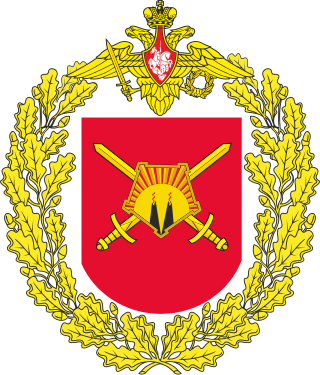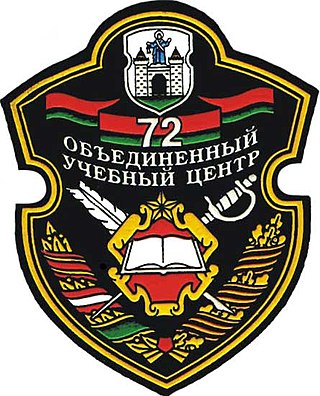
The 39th Separate Guards Red Banner Motor Rifle Brigade is a mechanized infantry brigade in the Russian Ground Forces. Originally formed as the Blagoveshchensk Fortified Region of the Soviet Union's Red Army in 1932, it became the basis for the 2nd formation of the 342nd Rifle Division and took part in the Soviet invasion of Manchuria. During the Cold War, it was reformed as the 56th Motor Rifle Division and later re-designated as the 33rd Separate Motor Rifle Division. In 2009, it was downsized and reorganized into the 39th Separate Motor Rifle Brigade as part of the 2008 Russian military reform.
The 101st Rifle Division was a unit of the Soviet Red Army initially formed as a mountain rifle division on 28 August 1938 within the 2nd Separate Red Banner Army in Petropavlovsk-Kamchatsky city.
The 12th Rifle Division was an infantry division of the Red Army, formed twice. The division's first formation fought in the Russian Civil War and Polish–Soviet War. It was disbanded in 1921. The division formed again in 1923 at Omsk and spent World War II in Siberia. It participated in the Soviet invasion of Manchuria and was converted into a motor rifle division in 1957.
The 14th Rifle Division was an infantry division of the Red Army. Formed in Moscow in 1922, the division spent most of the interwar period at Vladimir. After moving to the Kola Peninsula during the Winter War, the division fought on that front during the Continuation War. After the end of the Continuation War it became the 101st Guards Rifle Division.
The 15th Rifle Division was a military formation of the Red Army formed by renaming the Red Army's Inza Revolutionary Division on 30 April 1919. The division was active during the Russian Civil War and World War II.
The 86th Rifle Division was an infantry division of the Soviet Union's Red Army during the interwar period, World War II, and the early postwar period, formed twice.
The 69th Rifle Division was an infantry division of the Red Army and later the Soviet Army, formed twice.
The 36th Rifle Division was a division of the Red Army and then the Soviet Army. The division was formed in 1919 as the 36th Rifle Division and fought in the Russian Civil War and the Sino-Soviet conflict of 1929. In 1937 it became the 36th Motorized Division. The division fought in the Battles of Khalkhin Gol. It was converted into a motor rifle division in 1940 and fought in the Soviet invasion of Manchuria in World War II. Postwar, it became a rifle division again before its disbandment in 1956. The division spent almost its entire service in the Soviet Far East.
The 207th Rifle Division began its combat path under unusual circumstances. It was partly formed for the first time as a standard Red Army rifle division in the spring of 1941, before the German invasion, but was never completed. A second formation began in April 1942 and was completed on June 1, after which it was sent to the Stalingrad Front. Heavily depleted in counterattacks against the north flank of German Sixth Army, by November the survivors were reassigned and the division disbanded. The 207th was formed for a third time in June 1943, and fought its way through the central part of the Soviet-German front, ending the war in the heart of Berlin in the battle for the Reichstag. The division saw postwar service in the Group of Soviet Forces in Germany.
The 40th Rifle Division was an infantry division of the Red Army during World War II. It gained the honorific "named for Sergo Ordzhonikidze" on 14 April 1937. It fought in the engagements at Lake Khasan. On 22 June 1941, it was part of the 39th Rifle Corps, 25th Army, in the Far East Military District. The division fought in the Soviet invasion of Manchuria in 1945. In 1957, it was converted into a motorized rifle division. From 1957 to 1989 it was based at Smolyaninovo-1, Primorskiy Krai. In 1989 it was transferred to the Pacific Fleet as a coastal defence division. It was disbanded in 1996.
The 47th Rifle Division was an infantry division of the Red Army. It was first formed in 1922 as the Georgian Rifle Division. In 1924, it became the 1st Georgian Mountain Division. The division became the 47th Georgian Mountain Rifle Division in 1936 and dropped the designation "Georgian" in 1940. It was disbanded in June 1942 after being wiped out at Izyum. In July 1942, the 47th Rifle Division was formed from the 21st Rifle Brigade. It fought in the Nevel Offensive, for which it was awarded the title "Nevel". The division was disbanded in the Baltic Military District in 1946. It was also awarded the Order of Lenin and the Order of Suvorov 2nd class. The division was reformed a third time from the 277th Rifle Division in 1955 but disbanded in July 1956.

The 72nd Guards Joint Training Centre is a training centre of the Belarus Armed Forces. It trains warrant officers and junior specialists for the Belarus Armed Forces and is based in Borisov. The centre is currently led by Colonel Igor Korol. The 72nd Guards Joint Training Centre traces its history back to the Soviet 120th Rifle Division. For its actions during the Yelnya Offensive, the division became the 6th Guards Rifle Division in September 1941. In November 1945, the division became the 15th Guards Mechanized Division. On 15 May 1957, it became the 47th Guards Tank Division. The division became a training unit in 1960 and was renamed the 45th Guards Tank Training Division in 1965. In 1987, it became the 72nd Guards District Training Centre. In 1992, it was taken over by Belarus and became the 72nd Guards Joint Training Centre.
The 120th Rifle Division was an infantry division of the Red Army, formed three times. Its first formation became the 6th Guards Rifle Division for its actions in the Yelnya Offensive. Its second formation became the 69th Guards Rifle Division for its actions in the Battle of Stalingrad. The division was reformed a third time in late April 1943. It was disbanded "in place" with the Central Group of Forces in the summer of 1945.
The 49th Rifle Division was a Soviet Army infantry division, formed three times. First formed as a territorial division in 1931, the 49th Rifle Division's first formation became a regular division by 1939 and fought in the Winter War. For its actions during the war, it was awarded the Order of the Red Banner. However, the 49th Rifle Division was wiped out during the first ten days of Operation Barbarossa. Its second formation occurred in December 1941 and fought at Stalingrad, Kursk, the Vistula-Oder Offensive and the Battle of Berlin. The second formation was disbanded in 1946. The division was reformed in 1955 by renaming the 295th Rifle Division and became the 49th Motor Rifle Division in 1957.
The 50th Rifle Division was an infantry division of the Red Army from 1936 to 1946. The division took part in the Soviet invasion of Poland and the Winter War. After Germany launched Operation Barbarossa, the 50th fought in the Battle of Moscow, the Battles of Rzhev, the Donbass Strategic Offensive, the Dnieper–Carpathian Offensive, the First and Second Jassy–Kishinev Offensive, the Vistula–Oder Offensive and the Berlin Offensive.
The 137th Rifle Division was an infantry division of the Red Army in World War II. Raised in 1939 as a standard Red Army rifle division, it served for the duration of the Great Patriotic War in that role. The division fought in the central part of the Soviet-German front. It shared credit with other formations for the liberation of Bobruisk during Operation Bagration, and ended the war in the conquest of East Prussia.
The 404th Rifle Division was an infantry division of the Soviet Union's Red Army during World War II. Formed in late 1941, the division fought in the Battle of the Kerch Peninsula and was destroyed there in May 1942.
The 56th Rifle Division was an infantry division of the Red Army and later the Soviet Army of the Soviet Union, formed three times.
The 58th Rifle Division was an infantry division of the Red Army formed during the interwar period. Its second formation during World War II gained the Oder honorific.
The 1st Tank Division was a Division sized unit of the Red Army that existed from 1940–42. It was later reformed, from a separate formation, with a different lineage. Within the Soviet Ground Forces it existed as a second line ready division from 1945–2008, at Kaliningrad in the Baltic Military District.

